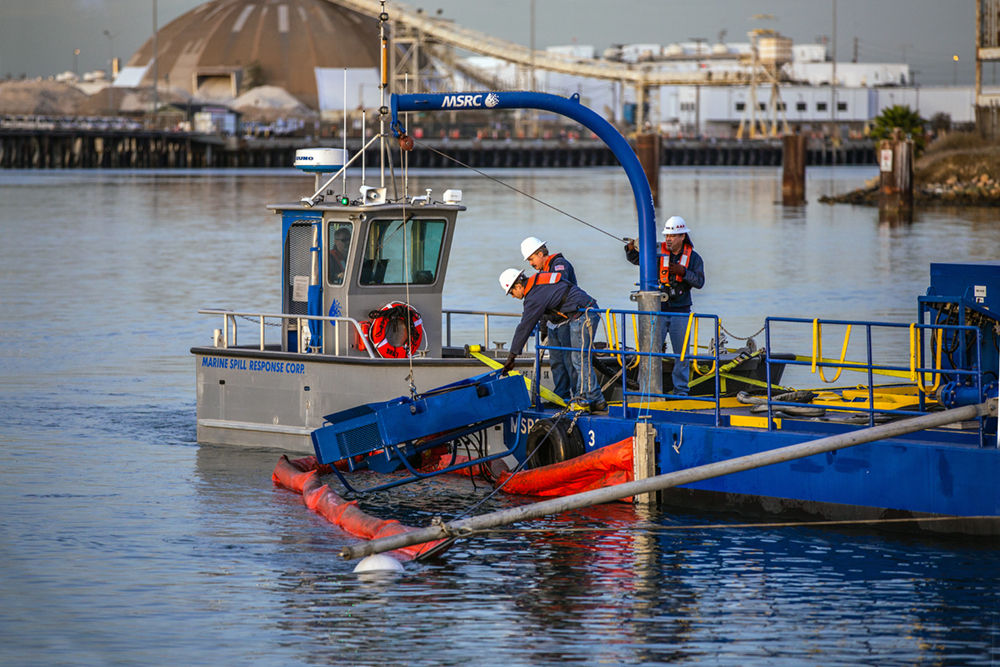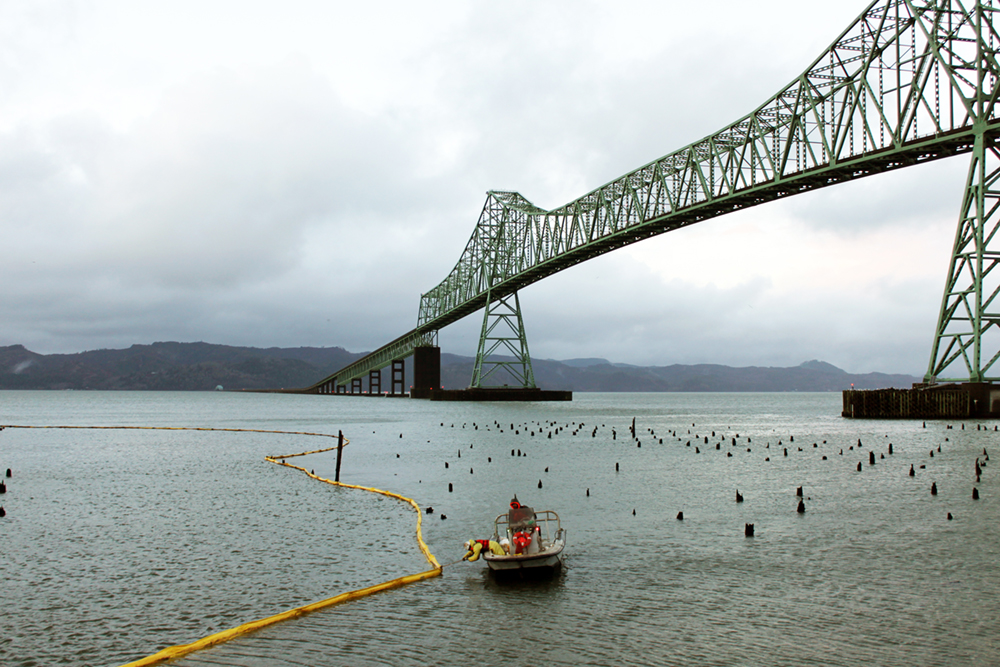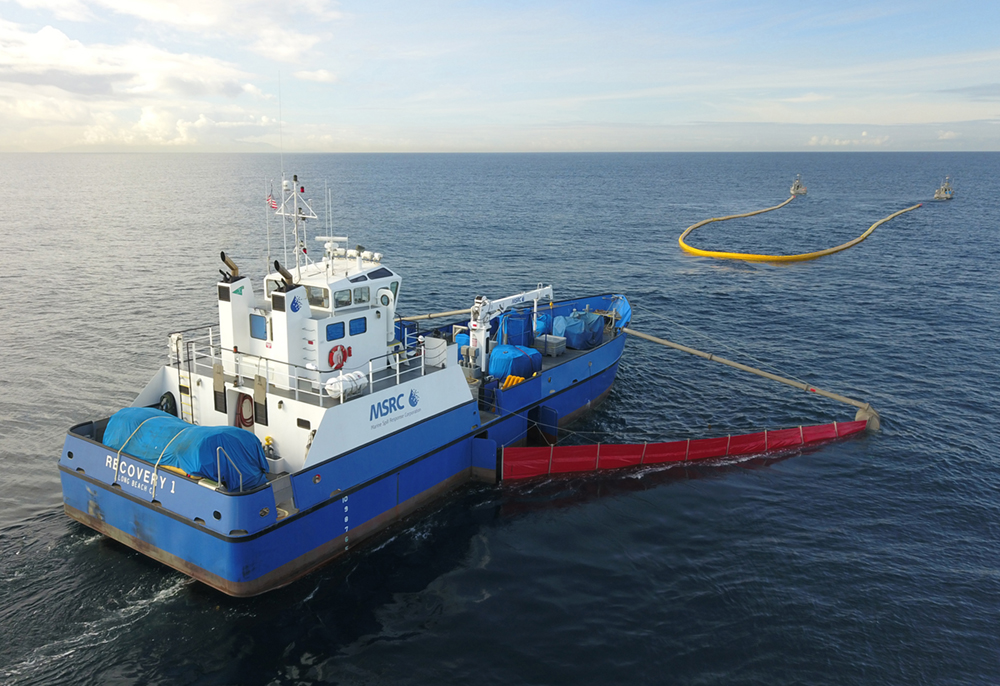
The COVID-19 pandemic slowed some aspects of the commercial maritime industry in 2020, particularly in the early months of the coronavirus’ emergence. But less than a year later, much of the industry returned to business as usual.
In addition to that degree of normalcy, an unfortunate byproduct of maritime operations has also returned – spills of oil and other substances from commercial vessels. But since COVID hasn’t completely disappeared, responders to such spills have to take an even more measured approach to how they handle such situations.
Pacific Maritime spoke with a number of spill response industry professionals about various subjects of importance to the industry, including notable changes and advances in spill response procedures and techniques; potential future advancements in spill response procedures; and how the pandemic has affected spill response and recovery efforts.
First, regarding how has the rise of the COVID has affected spill response and recovery, Ryan Sharratt, CEO of Oregon-based full-services firm NWFF Environmental, said that the coronavirus has changed the landscape of business and how hygiene plays into overall personal and professional health.
“Globally, humans are more cognizant of infections, diseases and the COVID-19 virus,” he explained. “Our industry utilizes personal protective equipment protecting two of our four routes of exposure, and therefore we have a lessened impact from this virus with our field crews.”
He also stated that his company’s business operations weren’t as affected by the pandemic as they could have been because it had already been upgrading its technology.
“Our administration was two years into a virtual migration (to cloud-based administration) before the pandemic, which lead to a continuity of operations that enabled NWFF to continue without lost time,” he explained.
John Silva, vice president of emergency response and preparedness for Moran Environmental Recovery and its subsidiary, Global Diving & Salvage, said that the pandemic served as a reminder that spill response is not the type of work that can be effectively managed remotely.
“Our industry is hands-on, and the work we do is labor-intensive and cannot be restricted by social distancing,” he stated. “In the early days of the pandemic, our executive team discussed the possibility that a portion or even all of our workforce could become unavailable due to COVID-19. We immediately pivoted to response mode with heightened protection of our critical workforce as our top priority, enabling us to continue to support our clients throughout the crisis.”
He went on to explain that successful spill response starts well before a single drop has even fallen; it begins when spill management teams prepare, train and plan to maintain a constant state of readiness.
“While the pandemic didn’t directly impact our ability to respond, it certainly affected our ability to train and prepare in person with our clients,” he said. “The pandemic forced the industry to pivot and lean on technology and video conference platforms more than ever before.”
“The virtual world quickly became part of our training exercises; however, it cannot fully replace field operations and deployments,” he added.
Ceren Karaer, (pronounced Jeren Caaray-ur), the director of business development for Marine Spill Response Corp., told Pacific Maritime that her company actually did not have a difficult time transitioning to virtual work.
“We got a lot of self-validation just in that we were able how to figure out how to work virtually pretty easily, we were able to turn command centers into virtual work scenarios, and do it really effectively,” she said.
“A lot of the feedback from our folks in the field was that doing a virtual command center is actually pretty productive,” she continued. “As you can imagine, it’s a lot less hectic, it brings the noise level way down, you’re able to go off into your breakout group with the folks that you need to be focused on working with, but then easily tie back in to the larger group.”
“The command center was the biggest question because that was the biggest risk exposure than the guys working in the field,” she said, before adding that not everything ran perfectly.
“There were some delays in response times because of the check-in protocol, but it really wasn’t material,” she explained. “Response times weren’t impacted nearly as much as we thought they would be.”
One issue that remains, she said, is that some people remain hesitant or skeptical about receiving the COVID vaccination, even if they’re in a job that requires them to sometimes work in close quarters with other people.
“It’s really important that as many as our folks as vaccinated as possible to make sure that we’re doing what we can to protect our own folks and keep them safe,” she said. “And that is in fact a challenge, given that nature that it’s a controversial thing (to receive a COVID vaccination).”

Industrial Changes
Regarding notable changes or advances in spill response procedures and techniques during recent times, but before the pandemic, Sharratt said that the most notable change that NWFF has seen in the industry over the past couple of years is skilled labor and tenure within the environmental response community.
“A changing workforce from seasoned professionals to newer workforce industry practices is currently being redefined by the available download ability from the generational handoff,” he explained. “This is changing the way that our industry has traditionally completed processes and procedures while the handoff is transferring to the most digitally connected generation of all time.”
“Information is at their fingertips, as well as innovation, new ideas, and a diversity-based approach never seen before,” he added.
Another notable change mentioned by Todd Duke, the Anchorage, Alaska-based general manager of compliance services with emergency response and salvage and wreck removal services provider Resolve Marine Group, is that his company received a patent for a sub-surface oil removal system a couple of years ago.
“This is a way of actually drilling into a ship’s hull and removing the oil. This is keeping the oil from getting into the environment,” he explained. “Imagine if you will a ship is on its side, it’s sunk so you really can’t pump the oil from the tanks in the normal method in which you would do if a ship was upright and operating correctly. So, what we do is we attach a flange, drill through that flange into the hull of the ship and then … we’re pulling oil out. The process is not all that new, it’s just a hug improvement in the process over what’s been done over the years. You can do it much faster and safer.”
“Shipwrecks don’t improve with age, obviously, and the longer something stays aground or sunk, the greater the chances of the oil getting released, so the sooner you can get tapped into those tanks and suck the oil out, the better it’s going to be for the environment,” he explained.
Silva remarked that one of the more notable changes in recent years has been the creation of the Non-Floating Oil (NFO) classification by the United States Coast Guard, saying that it has “significantly” advanced the response industry.
“For an Oil Spill Response Organization to obtain this classification, they must exhibit the ability to meet the required response time (of 24 hours) and have the equipment and trained personnel to detect, recover and store sunken oils in a variety of environmental conditions,” he explained.
Detection methods that support the classification, he said, include sonar imaging; ROV- underwater visualization and insitu-sampling; divers ground truthing; and V-SORs. Recovery options may include V-SORs; ROV-directed pumping; mechanical removal/dredge; and diver-directed pump & vacuum.
“Utilizing one or a combination of these methods is a critical initial response step to developing a successful recovery plan,” Silva remarked. “Utilizing our traditional OSRO techniques combined with the expertise of commercial divers often provides the best response option in efficiently and effectively mitigating the environmental impact of a spill.”
Storage options, he said, are dependent on the selected recovery method.
“The use of portable bladders and barges are common but with this type of operation, you can generate huge amounts of water and need to have a plan to deal with and manage that,”
he explained.

On the Horizon
So, what does the future hold for the spill and response industry? Could there any changes in the works on the horizon when it comes to response procedures?
Duke said that there’s research into nanotechnologies in progress that’s he’s aware of. It’s still in its infancy, he said, but does show some promise when it comes to removing oil from the environment.
Karaer added two of the pressing questions regarding what’s on the horizon for her industry involve the use of dispersants and solidifiers.
“One thing that we kind of struggle with regarding oil spill response in the U.S. is the use of dispersant,” she said. “It’s a very controversial tool and therefore it is a concern. That said, from the perspective of spill response, if you need to disperse oil quickly, it’s an incredibly effective tool.”
“It’s a real challenge to get the approval for it to be used in the U.S. with the regulatory structure that we have in place, whereas in the rest of the world, most vessels have dispersant onboard and if they spill something overboard, they deploy it right away,” she added.
“It’s really remarkable that it’s something we can use everywhere else in the world, but when it comes to U.S. waters, it’s a totally different story,” Karaer continued. “So, if there’s work that we could do to get all the stakeholders more comfortable with using that tool so that we can be ready to deploy it … that would be great.”
Regarding use of solidifiers, which are chemical solutions that interact with oil to limit hydrocarbon release into air and water and prevent it from adhering onto sediment and debris, Karaer said that their potential should be explored.
Currently, their use is limited to small spills near shorelines; research into extending the use of solidifiers to large-scale spill containment operations is still ongoing within the scientific community.
“Solidifiers are not really in our tool kit. I think there’s one solution that’s approved by the EPA, but no one’s every really used it,” she remarked. “And there’s a lot of questions about how solidifiers actually work – how do you mechanically remove it?”
“So, there would be more work to do there, to figure out how to actually use solidifiers with particular products and determine what the recovery tactics would be,” she said, while remarking that solidifiers’ use has the potential to increase the viscosity of products that have been spilled and then mitigate significantly, if not totally eliminate, the emission of volatile organic compounds, thereby resolving a lot of safety concerns.
Also regarding what’s on the horizon, Silva said that one area that should be addressed is regulations to support the Non-Floating Oil classification and require plan holders to have an NFO-classified Oil Spill Response Organization.
“Many plan holders that deal with the NFO have an NFO-OSRO listed in their plan, but many do not realize that other oils can become an NFO if the conditions are right,” he explained. “Oil can become weathered; it can also trap sediment and become heavy and wave action and salinity can impact its ability to stay on the surface. Even a light oil like a No. 2 oil can become an NFO if the conditions are right.”
Not many OSROs have the NFO classification because of the investment needed to meet the requirements, he remarked, adding that currently there are only 10 OSROs listed in the U.S. Coast Guard’s Response Resource Inventory System that meet the requirements.

Also among the changes on the horizon, Sharratt remarked, are reclamation, recycling and energy awareness.
“We see diversity in the age-old throw-it-away approach into an industrial symbiosis approach with hazardous waste — mercury, lead, etc. — and energy-stored wastes — oils, fuels, etc.,” he explained. “In my opinion, this industry still has a significant hurdle in becoming proactive in consumption management rather than waste management.”
“We can shift our efforts into environmentally friendly substitutions or quantity-driven controls, limiting waste streams,” he added. “To accomplish this, society in general will require a systemic shift in thought about conservation rather than consumption.”
Duke added that he feels that the maritime industry has begun doing a really good job at preventing spills, but in itself has led to another issue to deal with.
“Spills are becoming fewer and farther in between,” he remarked. “The problem with that though, is that a lot of people who have lots of good experience in cleaning spills up, they’ve retired, they’ve gone on to do other things, and so we’re beginning to lose that knowledge base, and the people coming up behind us are not quite as experienced in cleaning up heavy oils.”
“There’s a diesel spill every day or a hydraulic fluid spill every day somewhere in the United States – I would say hundreds of these every day. People are really good at cleaning those up,” he said. “But it’s those heavy oils and things, it is quite concerning what little bit of experience that the industry has now in cleaning those up.”
He said that the increasing lack of spills has led to a Catch-22; people can’t get more experience unless they’re cleaning up spills, but with fewer and fewer spills occurring, there’s fewer opportunities for those newer to the spill response industry to gain real world experience.
“The young kids,” he said, “need better training.”
